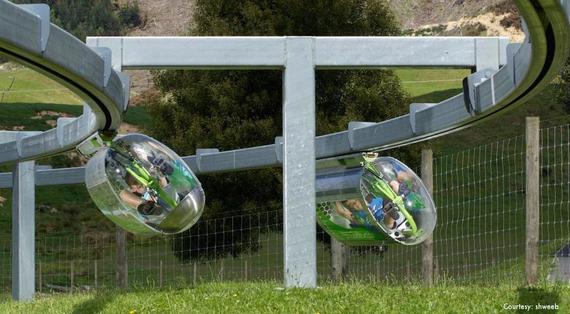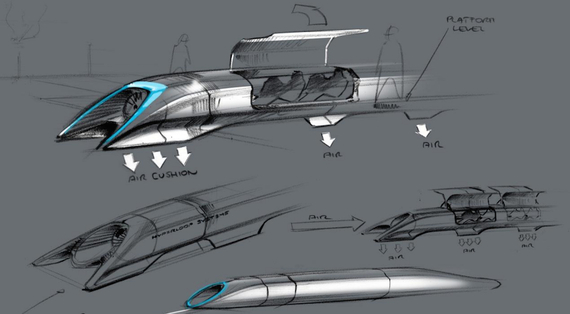Don Willmott is a New York-based journalist who writes about technology, travel, and the environment for a wide variety of publications and websites.
What do we know about the future? It will be sleek and streamlined; the Internet will be faster; Elon Musk will be king; and we'll all travel in pods.
Pods? For some inexplicable reason, almost every vision of the future has us shuttling around our cities in one kind of pod or another, tapping into the efficiency of mass transit while providing us the privacy, flexibility, and nonstop service we demand. If it was good enough for "Logan's Run," then it should be good enough for us.
A handful of entrepreneurs--Mr. Musk included--are already heading down the pod, or "Personal Rapid Transit" (PRT), path, with plans, schemes, and even some working prototypes that posit sensible transportation for tomorrow--even if it means reinstalling the kinds of elevated tracks that cities like New York tore down 60 years ago.
Shweeb's pedal-powered pods have attracted the attention of Google. (Source: shweeb.com)
Take, for example, Shweeb, a Canadian company whose pedal-powered pods will get us around town and provide a cardio workout at the same time. Its proposed Skysmart System would suspend solar or pedal-powered pods on tracks high above the street to take two, five, or 12 people directly to their destination without platforms, fixed routes, or timetables.
Schweeb says Skysmart would be at least 30 percent less expensive to build than alternatives, it could move 10,000 people--plus cargo--per hour, and that its pylons and tracks could do double duty as infrastructure conduits. For now, you can see a version in action at a New Zealand amusement park, and Schweeb hopes not only to build a serious demonstration installation in Niagara Falls, but also to find a home at Google's main campus.
JPods is buidling solar-powered rail network in New Jersey. (Source: JPods.com)
Secaucus, New Jersey of all places may be the demonstration site of another intriguing PRT system called JPods. With $120 million of investor money in the bank, CEO Bill James, a military logistics veteran, shares the overhead personal pod vision and plans to power it with solar collectors mounted on top of the elevated tracks. Like other PRT systems, JPods, which would carry from one to four riders, could be programmed for nonstop point-to-point trips using one-tenth the energy of cars, trains, or buses as they travel. The solar collectors above the tracks would collect 25,000 vehicle-miles of power per mile of rail per day.
JPods is actually starting out with a portable 328-foot installation, a proof-of-concept "rescue rail system" that could be deployed temporarily in a disaster zone with solar power providing all the necessary juice. From there, the company wants to build almost 1,000 feet of rail to do further testing and take paying passengers for the first time. As for Secaucus, a congested rail and car transit hub just west of New York City, town planners have granted rights of way to safe technologies that can exceed a benchmark of 120 passenger miles per gallon of fuel. The true test of JPods would be a three-mile stretch there with a dreamy vision that one day it would extend across the George Washington Bridge into Manhattan.
Sketches of Elon Musk's Hyperloop, a vacuum tube transportation system that would move passengers in pods at speeds approaching 800 mph. (Source: SpaceX)
And as for Elon Musk, talk of his tubular 800-mph Hyperloop, in which passengers would be literally shot cross-country, has futurists dazzled, and now a new company called Hyperloop Transportation Technologies is taking up the challenge, planning to build a five-mile, $100 million test track in central California. Musk himself tweeted in January that he would build his own Hyperloop test track, likely in Texas, to let student engineers test--and race--pod prototypes. Now that sounds like fun.
Visit XPRIZE at xprize.org, follow us on Facebook, Twitter and Google+, and get our newsletter to stay informed.
Our 2024 Coverage Needs You
It's Another Trump-Biden Showdown — And We Need Your Help
The Future Of Democracy Is At Stake
Our 2024 Coverage Needs You
Your Loyalty Means The World To Us
As Americans head to the polls in 2024, the very future of our country is at stake. At HuffPost, we believe that a free press is critical to creating well-informed voters. That's why our journalism is free for everyone, even though other newsrooms retreat behind expensive paywalls.
Our journalists will continue to cover the twists and turns during this historic presidential election. With your help, we'll bring you hard-hitting investigations, well-researched analysis and timely takes you can't find elsewhere. Reporting in this current political climate is a responsibility we do not take lightly, and we thank you for your support.
Contribute as little as $2 to keep our news free for all.
Can't afford to donate? Support HuffPost by creating a free account and log in while you read.
The 2024 election is heating up, and women's rights, health care, voting rights, and the very future of democracy are all at stake. Donald Trump will face Joe Biden in the most consequential vote of our time. And HuffPost will be there, covering every twist and turn. America's future hangs in the balance. Would you consider contributing to support our journalism and keep it free for all during this critical season?
HuffPost believes news should be accessible to everyone, regardless of their ability to pay for it. We rely on readers like you to help fund our work. Any contribution you can make — even as little as $2 — goes directly toward supporting the impactful journalism that we will continue to produce this year. Thank you for being part of our story.
Can't afford to donate? Support HuffPost by creating a free account and log in while you read.
It's official: Donald Trump will face Joe Biden this fall in the presidential election. As we face the most consequential presidential election of our time, HuffPost is committed to bringing you up-to-date, accurate news about the 2024 race. While other outlets have retreated behind paywalls, you can trust our news will stay free.
But we can't do it without your help. Reader funding is one of the key ways we support our newsroom. Would you consider making a donation to help fund our news during this critical time? Your contributions are vital to supporting a free press.
Contribute as little as $2 to keep our journalism free and accessible to all.
Can't afford to donate? Support HuffPost by creating a free account and log in while you read.
As Americans head to the polls in 2024, the very future of our country is at stake. At HuffPost, we believe that a free press is critical to creating well-informed voters. That's why our journalism is free for everyone, even though other newsrooms retreat behind expensive paywalls.
Our journalists will continue to cover the twists and turns during this historic presidential election. With your help, we'll bring you hard-hitting investigations, well-researched analysis and timely takes you can't find elsewhere. Reporting in this current political climate is a responsibility we do not take lightly, and we thank you for your support.
Contribute as little as $2 to keep our news free for all.
Can't afford to donate? Support HuffPost by creating a free account and log in while you read.
Dear HuffPost Reader
Thank you for your past contribution to HuffPost. We are sincerely grateful for readers like you who help us ensure that we can keep our journalism free for everyone.
The stakes are high this year, and our 2024 coverage could use continued support. Would you consider becoming a regular HuffPost contributor?
Dear HuffPost Reader
Thank you for your past contribution to HuffPost. We are sincerely grateful for readers like you who help us ensure that we can keep our journalism free for everyone.
The stakes are high this year, and our 2024 coverage could use continued support. If circumstances have changed since you last contributed, we hope you'll consider contributing to HuffPost once more.
Already contributed? Log in to hide these messages.



